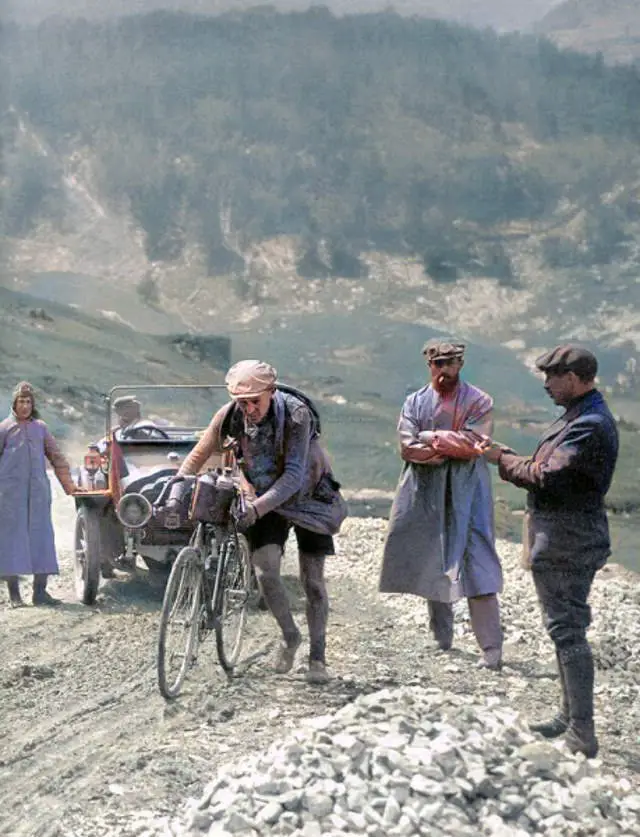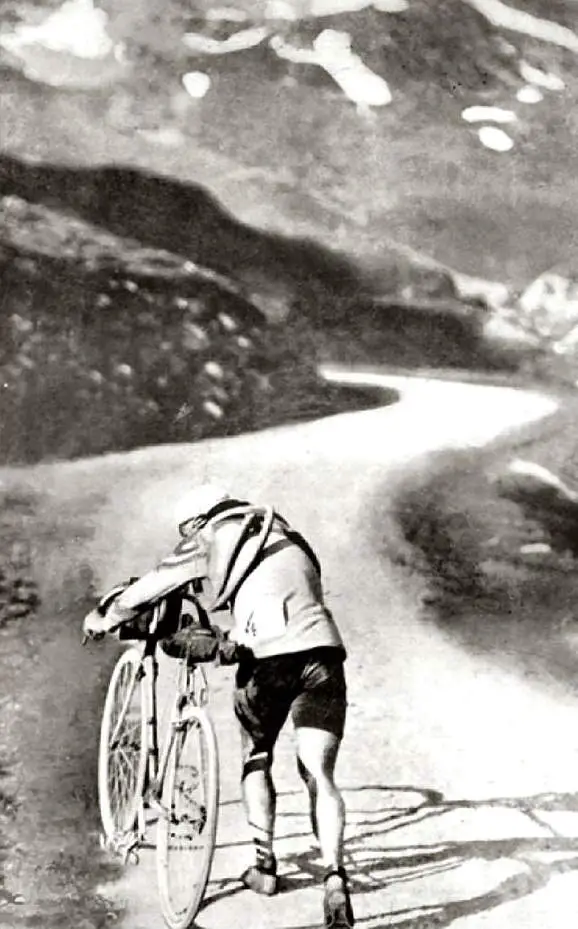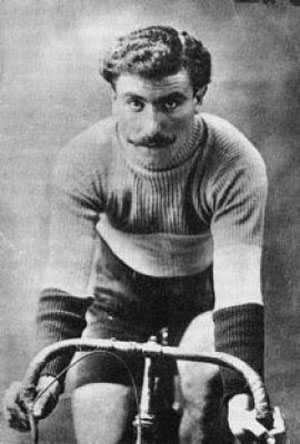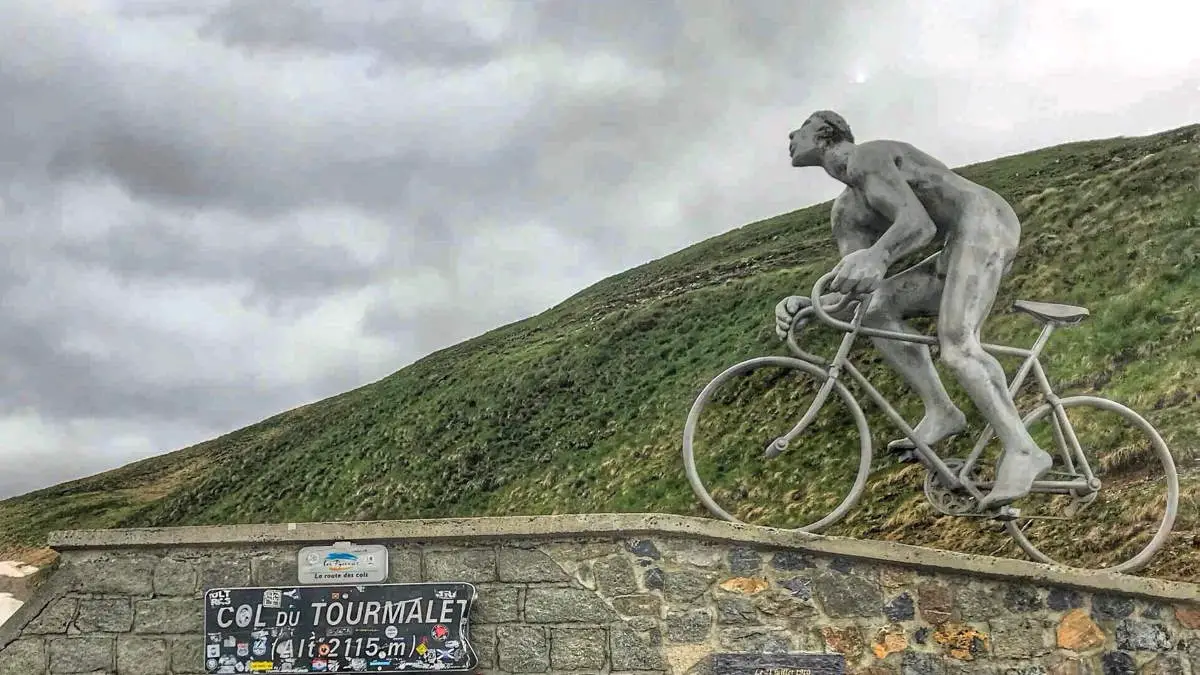Today’s historic photo of the day: the first-ever stage ascent of Col du Tourmalet in Tour de France (1910), Octave Lapize of the Alcyon team walks over the summit and goes on to win the Tour. When he passed the organizer’s car atop the Tourmalet, he screamed “Vous êtes des assassins! Oui, des assassins!” (French for “You are murderers! Yes, murderers!”)
The courses of the Tour de France in 1907, 1908, and 1909 had been nearly identical. But in 1910, the Pyrenees were included, an initiative from Adolphe Steinès, who had drawn the course for the Tour de France since the first Tour in 1903.
Compared to 1907, 1908 and 1909 Tours, the stages Nîmes-Toulouse and Toulouse-Bayonne were replaced by three stages, Nîmes-Perpignan, Perpignan-Luchon and Luchon-Bayonne. At first, Tour organizer Henri Desgrange refused the inclusion of the Pyrenees, but later gave in and sent Steinès to the Pyrenees by to see if it was possible to send cyclists up the mountains.

Steinès went to the Pyrenees on 27 January 1910 and asked an innkeeper for directions over the Tourmalet. The innkeeper replied that it is barely crossable in July, so practically impossible in January. Steinès hired a car anyway and rode up the mountain.
Close to the top, there was so much snow that the car could not go further, and he continued on foot. Steinès walked during the night and fell down a ravine. At 3 a.m. he was found by a search party. He quickly got some food and a hot bath. The next morning, he sent a positive telegram to Desgrange:
“Have crossed the Tourmalet on foot
Adolphe Steinès
STOP
Road passable to vehicles
STOP
No snow
STOP”
When it was announced that the Pyrenees were included in the race, 136 cyclists had entered the race. After the news, 26 cyclists removed themselves from the starting list. In fact, the cyclists were not so enthusiastic about the inclusion of the Pyrenées, and there were fewer participants: 110 instead of 150 in 1909. Some newspapers reacted to the Tour’s route as “dangerous” and “bizarre”.
Also new in 1910 was the broom wagon, to pick up the cyclists that abandoned during the race. This was a reaction of the Tour organizers to the criticism of the cyclists on the difficult mountains. In the tenth stage, over the four mountains in the Pyrenees, cyclists were allowed to finish the stage in the broom wagon and still start the next stage.
Technically, a new addition was the gears. Lucien Petit-Breton, Maurice Brocco, Henri Cornet, Charles Pavese, and Jean Alavoine rode with gears.
“Variable gears are only for people over forty-five. Isn’t it better to triumph by the strength of your muscles rather than by the artifice of a derailleur? We are getting soft. Give me a fixed gear.”
Henri Desgrange
What had not changed was the points system. A cyclist received points, based on their rankings. As in 1909, the points system was “cleaned up” two times: after the 9th stage and after the 14th stage. Cyclists who had abandoned the race were removed from the rankings of the previous stages, and the classification was recalculated.
There were three teams with 10 cyclists each, including all the favorites for the overall victory: Alcyon, Le Globe and Legnano. The French team “La Française” decided not to join but allowed their cyclists to ride for the Italian Legnano team. The other 80 cyclists rode as individuals, this was called the “isolés” category.
The first stage, from Paris to Roubaix, was won by Charles Crupelandt. In the second stage, François Faber showed his strengths and won the stage, and took the lead.
On the rest day between the sixth and seventh stage in Nice, cyclist Adolphe Hélière died whilst swimming. He was the first victim of the Tour de France. In the ninth stage, four mountains were climbed, and Desgrange saw how much trouble the cyclists had on these mountains. The tenth stage would include the Pyrenees mountains, so Desgrange left the race and made Victor Breyer the director of the stage.
You are murderers! Yes, murderers!
In that tenth stage (July 21, 1910), the Col du Tourmalet was climbed, the highest point of the 1910 Tour de France. The stage in question was 326 kilometers in length, featured 7 brutal climbs, and was raced on unsealed roads with single-gear bicycles. Octave Lapize reached the top first, followed by Gustave Garrigou.
Garrigou was the only cyclist who reached the top without dismounting and received an extra prize of 100 francs for that. The next climb was the Aubisque. Lapize struggled there, and regional rider François Lafourcade lead the race.
The organizers had a car standing at the top, and when Lafourcade passed them, they did not recognize him, and when they found out it was Lafourcade, they were surprised that such an unknown rider had been able to pass all the ‘cracks’. When Lapize passed the organizer’s car, he screamed “Vous êtes des assassins! Oui, des assassins!” (French for “You are murderers! Yes, murderers!”) and announced that he would give up during the descent.
He refound his legs in the downhill and was able to catch up Lafourcade, and even win the stage.


After the 12th stage, Faber was leading the race by only one point. In that stage to Brest, Faber punctured, and Lapize took over the lead, helped by Garrigou.
In the 14th stage, Faber sped away almost from the start in what could be his last chance to win the Tour de France. It seemed that he had a chance until a flat tire caused him to lose time, and Lapize could get back to him, again aided by Garrigou.
Lapize improved his lead by winning the stage and had a six-point margin before the last stage. In that last stage, it was Lapize who suffered from a flat tire, shortly after the start. Faber raced away, but could not pull off the stunt: he had a flat tire. He still finished ahead of Lapize, but won back only two points, so the 1910 Tour de France was won by Octave Lapize.
The First World War ended Octave Lapize’s cycling career. As a fighter pilot in the French army, he was shot down near Flirey (a commune in the Meurthe-et-Moselle department in north-eastern France) on 14 July 1917. Severely injured, he died in a hospital in Toul.



Most famous for winning the 1910 Tour de France and a bronze medal at the 1908 Summer Olympics in the men’s 100 kilometers, he was a three-time winner of one-day classics, Paris-Roubaix and Paris-Brussels.
Sources
- Octave Lapize on Wikipedia
- 1910 Tour de France on Wikipedia
- Top 18 fastest Paris-Roubaix editions - April 7, 2024
- Col de Tourmalet [Amazing photo from the 1953 Tour de France] - January 11, 2024
- Bernard Hinault and Francesco Moser, 1981 Paris-Roubaix - December 8, 2023

![Col de Tourmalet [Amazing photo from the 1953 Tour de France]](https://cdn-0.cycling-passion.com/wp-content/uploads/2024/01/Col-du-Tourmalet-Tour-de-France-1953-1024x668.jpg)